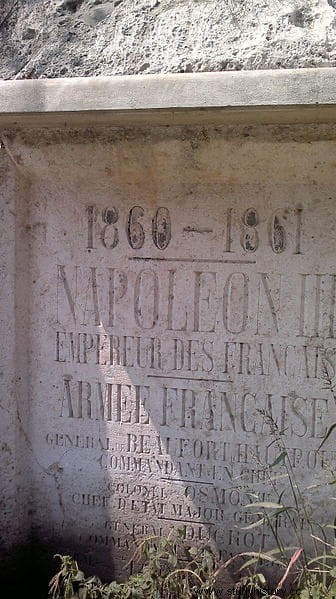The Nahr al-Kalb River (called Lykos in ancient times) rises near the town of Jeita and runs just 31 kilometers until it empties into the Mediterranean about 30 kilometers north of Beirut, the capital of Lebanon. It is not a particularly long river, and in summer it is usually practically dry. But the valley it forms and its mouth are of special interest for archeology and history.
And it is that since the fourteenth century B.C. Until contemporary times, generals, conquerors and kings have erected commemorative stelae there with dedications and reliefs, forming an impressive set of 20 stelae known as the Nahr al-Kalb Commemorative Stelae .
The first to give written notice of such a wonder was the 17th-century traveler Henry Maundrell in his 1703 book Journey from Aleppo to Jerusalem at Easter A.D. 1697 :

Franz Heinrich Weissbach, who studied the inscriptions in 1922, identified three Egyptian hieroglyphic stelae, six Neo-Assyrian and Neo-Babylonian cuneiform inscriptions, several Greek, Roman, and Arabic, as well as more modern French and English ones.

All three Egyptian inscriptions bear the name of Ramses II. It is believed that at least one of them was placed during the pharaoh's first campaign in the Levant, establishing the Lykos River as the border between the Egyptian province of Canaan and the territory of the Hittites.
However, the inscription is so worn that only the name of Ramses II and year 4 can be read. . Some researchers relate these inscriptions to Pharaoh Sesostris, according to what Herodotus says:

Of the six Neo-Assyrian and Neo-Babylonian cuneiform inscriptions, one account of the taking of Memphis by the Assyrian king Asarhaddon in 671 B.C. Although heavily damaged, references to the cities of Ascalon, Tyre, and Taharqa, as well as 22 vassal kings can be read. .
Another of the inscriptions is attributed to Nebuchadnezzar II, who was king of Babylon between 604 and 562 BC, famous for building the hanging gardens and conquer Judah and Jerusalem.
Among the Greco-Roman inscriptions, the one attributed to the Legio III Gallica of Emperor Caracalla stands out (originally recruited by Julius Caesar in 49 BC and whose last recorded activity dates back to the beginning of the 4th century in the Middle East), which refers to a road that they built there.
It is precisely this inscription that includes the words Lyco flumen that allowed researchers to identify the Nahr al-Kalb with the ancient Lykos River.
Another of the inscriptions, in Greek, commemorates an engineering work carried out by Proculus, the Byzantine governor of Phoenicia in 382 AD. during the reign of Theodosius I.

The oldest Muslim inscription is dedicated to the first sultan of the Buryid dynasty, who ruled Egypt from 1382 to 1517 during the Mamluk sultanate. Another, dedicated to Emir Fakhr-al-Din II of Lebanon, was no longer legible in the 19th century due to wear.
The tradition of erecting stelae and dedications at the site continued even into modern times. The first of the colonial inscriptions is dedicated to Napoleon III's intervention in Lebanon between 1860 and 1861 to restore order during the civil war that had begun with the Maronite Christian rebellion.
Another from 1919 recalls the taking of Damascus, Homs and Aleppo in October of the previous year by the Allied forces, at the end of the First World War.

From the 1920s it is the one left by the French troops of General Gouraud who took Damascus in July 1920 in the Battle of Maysalun. And in 1942 the allied forces carved another inscription commemorating the liberation of Syria and Lebanon from the Vichy regime.
Finally, in 1946, a monument was erected celebrating Lebanon's independence three years earlier. And in 2000 another commemorating the departure of Israeli troops from the country.

Today all the stelae and inscriptions are numbered, except those after 1920.
The only one found on the right bank of the river is that of Nebuchadnezzar II.
The others are arranged on the left bank, in an order that mixes periods and styles, sometimes overlapping, such as the 1942 obelisk that is placed just above the Roman inscription of Caracalla.
The reason so many kings, emperors and generals have left evidence of passing through Nahr al-Kalb is that the river formed a deep gorge that could only be crossed near its mouth.
Therefore, it was a step of strategic importance for the conquering armies.

The Egyptians were the first to open paths in the rock, enlarged by the Assyrians, to facilitate the journey. The Romans, in the time of Marcus Aurelius around 180 AD, carved a causeway into the steep hillside that ran some 30 meters above sea level.
